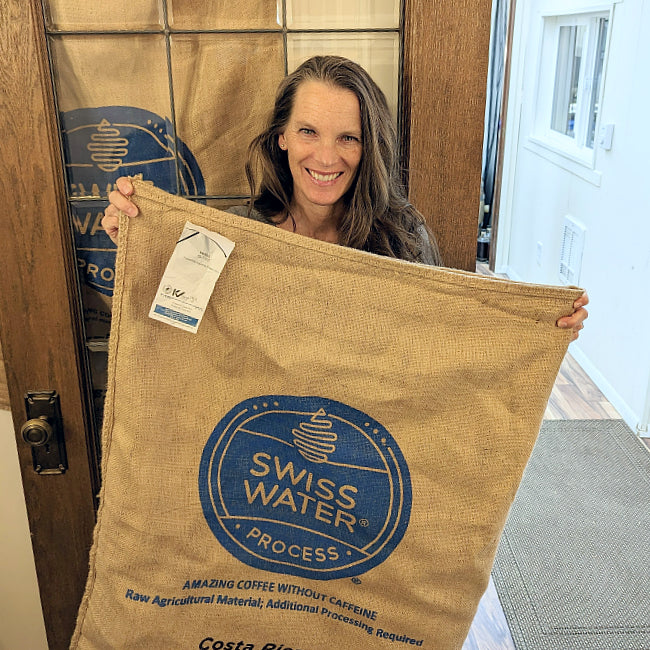Ways to use burlap coffee sacks in your garden.

Natural burlap bags are made from natural fibers such as flax, hemp, or jute and break down naturally providing nutrients to your soil and plants. Synthetic versions are also available, however, it’s best to choose natural jute bags that have not been deodorized, bleached, or sprayed with any chemicals.
There are several uses for burlap bags, the most common are:
- Weed Control
- Weather Protection
- Pest Protection
- Liners for plant baskets
- Growing and storing certain plants
WEED CONTROL
For the best weed control, pick the weeds out first, then lay the burlap down over freshly tilled beds. However, you can just place the burlap on top of the weeds. If you are using the burlap in paths, place some sand, soil, bark or rocks over the burlap. If you are using the burlap in the garden beds, cut slits in the burlap, then place your plants into the soil. Cover the burlap with mulch or use U-shaped pins to anchor the bags. We recommend that you cut the coffee sack open for a single long piece.
For tough weeds in your garden, place a layer of newspaper or cardboard down over the weeds first, then place the burlap over that. This acts as a barrier from weed seeds coming in contact with the soil.
The burlap is permeable and allows water to filter through to the soil. It will degrade naturally, if buried in the soil giving it vital nutrients. It’s best to replace the burlap the following growing season.
WEATHER PROTECTION
Burlap can protect plants and scrubs from cold winds and frost or from scorching heat. This can be done several ways.
Protect against frost by creating a burlap “tent” around the plants that need to be protected from cold winds. First, create a teepee with sticks around your plant being sure to leave a few inches between the plant and the sticks. Be sure the sticks are firmly secure in the ground, then wrap the teepee with the burlap.
Another method is to place a length of burlap on top of tender low-lying crops like lettuces to protect from frost. Remove it once temperatures warm up.
In hotter weather, burlap bags can make great sun-shades. Cut open your large burlap coffee sack along the two long sides to create a long piece. Attach the burlap to some poles such as a treated 2x2 (a little more than the height of your plants) with a nail. Place this over a veggie bed when the summer sun is too hot for salad greens. Providing this shade may prevent bolting of some plants.
For root vegetables, place a single layer of burlap directly over your plants and secure with plant stakes or large rocks.
PEST CONTROL
Need to keep critters such as rabbits, deer, mice, and other pests from nibbling on garden plants? Burlap is a terrific deterrent. One effective way to use burlap is to make a cube frame using 2x2 boards with burlap stapled to it to create the faces of the cube. Make it large enough so the burlap doesn’t touch the plants, and tall enough to keep small critters. For deer, you will need to add a “roof” face.
Sheets of burlap placed over the garden bed and secured with tent pegs or stones work nicely to protect newly-sown seeds from critters. Once seedlings are established, remove the burlap.
LINERS FOR PLANT BASKETS and DECORATIVE BASKETS
Did you know that burlap makes an excellent and attractive liner for wire planter baskets. Burlap being naturally strong and breathable, prevents soil from seeping out of the planter when watered, yet allows the excess water to drain.
To create a decorative planter, place your liner (if using one), soil, and plants into a burlap sack or the center of your piece of burlap, pull up the sides of the plant until the soil is fully contained within, and loosely tie a rope around the top.
Because burlap is strong and breathable, it is the perfect wrap for root balls of trees and shrubs.
GROWING AND STORING CERTAIN PLANTS
Potatoes are surprisingly easy to grow and thrive when placed into a tall burlap sack with some soil.
Tomatoes and peppers are also easy to grow using a burlap bag. Simply place some good quality soil in the bag, add the plants. Be sure to fold down the top edge to allow for sunlight.
You can store your root vegetables in burlap sacks. The nice, dry, dark, moisture-free place is breathable and does not mold. Depending on the vegetable, either place the vegetables directly into the sack and fold over the top to keep it sealed. Alternatively, you can add sand to the sack and burry your vegetables in the sand. Both methods should protect and prolong the life of your winter veggies.
Coffee and gardening, two of the best things, don't you agree.